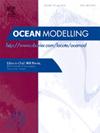Long-duration storm surges due to 2023 successive UK storms Ciarán and Domingos: Generation, field surveys, and numerical modelling
IF 2.9
3区 地球科学
Q2 METEOROLOGY & ATMOSPHERIC SCIENCES
引用次数: 0
Abstract
We model the long-duration storm surges generated by October–November 2023 storm chain in the English Channel employing a hybrid method including numerical modelling, field surveys and analysis of oceanic and atmospheric data. The event consisted of three successive storms: a weaker unnamed storm (27–30 October), Storm Ciarán (2–3 November with minimum pressure 948 hPa) and Storm Domingos (4–5 November with minimum pressure 958 hPa). The average surge duration produced by this storm chain was 10.5 days. The average maximum air pressure drop was 42 hPa during Ciarán and 23 hPa during Domingos. These pressure drops, combined with onshore wind stresses, led to average maximum storm surge amplitudes of 92 cm for Ciarán and 74 cm for Domingos. We accurately modelled storm surges using a three-level nested grid system and validated the results with tide gauge data. Sensitivity analysis showed a spatially-dependant impacts from tides and waves on maximum surge amplitudes. To correlate our modelling and data analysis with actual conditions on the ground, field surveys were conducted where we measured a runup heights of 4.1 m in Chesil Beach and 2.1 m in West Bay. These values were successfully reproduced by two independent empirical runup models enabling adaption of suitable models for storm hazard mitigation and resilience. A meteotsunami with an amplitude of 17–23 cm and a period of 11–40 min was identified during Ciarán. The innovative hybrid framework developed in this study is recommended for building robust systems for storm warnings and coastal resilience.
2023年英国连续风暴造成的长时间风暴潮Ciarán和Domingos:生成、实地调查和数值模拟
本文采用数值模拟、野外调查和海洋、大气数据分析等混合方法,对2023年10 - 11月英吉利海峡风暴链产生的长时间风暴潮进行了模拟。该事件由三个连续的风暴组成:一个较弱的未命名风暴(10月27-30日),风暴Ciarán(11月2-3日,最低气压948 hPa)和风暴Domingos(11月4-5日,最低气压958 hPa)。该风暴链产生的平均浪涌持续时间为10.5天。Ciarán期间平均最大气压降42 hPa, Domingos期间平均最大气压降23 hPa。这些压力下降,加上陆上风的压力,导致Ciarán的平均最大风暴潮振幅为92厘米,Domingos的平均最大风暴潮振幅为74厘米。我们使用三层嵌套网格系统精确地模拟了风暴潮,并用潮汐计数据验证了结果。敏感性分析表明,潮汐和波浪对最大浪涌振幅的影响具有空间依赖性。为了将我们的建模和数据分析与地面的实际情况联系起来,我们进行了实地调查,在切西尔海滩测量了4.1米的上升高度,在西湾测量了2.1米的上升高度。两个独立的经验累积模型成功地再现了这些值,从而使适当的模型适用于减轻风暴危害和恢复能力。在Ciarán期间发现了一次振幅为17-23 cm,持续时间为11-40 min的海啸。本研究中开发的创新混合框架被推荐用于建立强大的风暴预警和沿海恢复能力系统。
本文章由计算机程序翻译,如有差异,请以英文原文为准。
求助全文
约1分钟内获得全文
求助全文
来源期刊

Ocean Modelling
地学-海洋学
CiteScore
5.50
自引率
9.40%
发文量
86
审稿时长
19.6 weeks
期刊介绍:
The main objective of Ocean Modelling is to provide rapid communication between those interested in ocean modelling, whether through direct observation, or through analytical, numerical or laboratory models, and including interactions between physical and biogeochemical or biological phenomena. Because of the intimate links between ocean and atmosphere, involvement of scientists interested in influences of either medium on the other is welcome. The journal has a wide scope and includes ocean-atmosphere interaction in various forms as well as pure ocean results. In addition to primary peer-reviewed papers, the journal provides review papers, preliminary communications, and discussions.
 求助内容:
求助内容: 应助结果提醒方式:
应助结果提醒方式:


